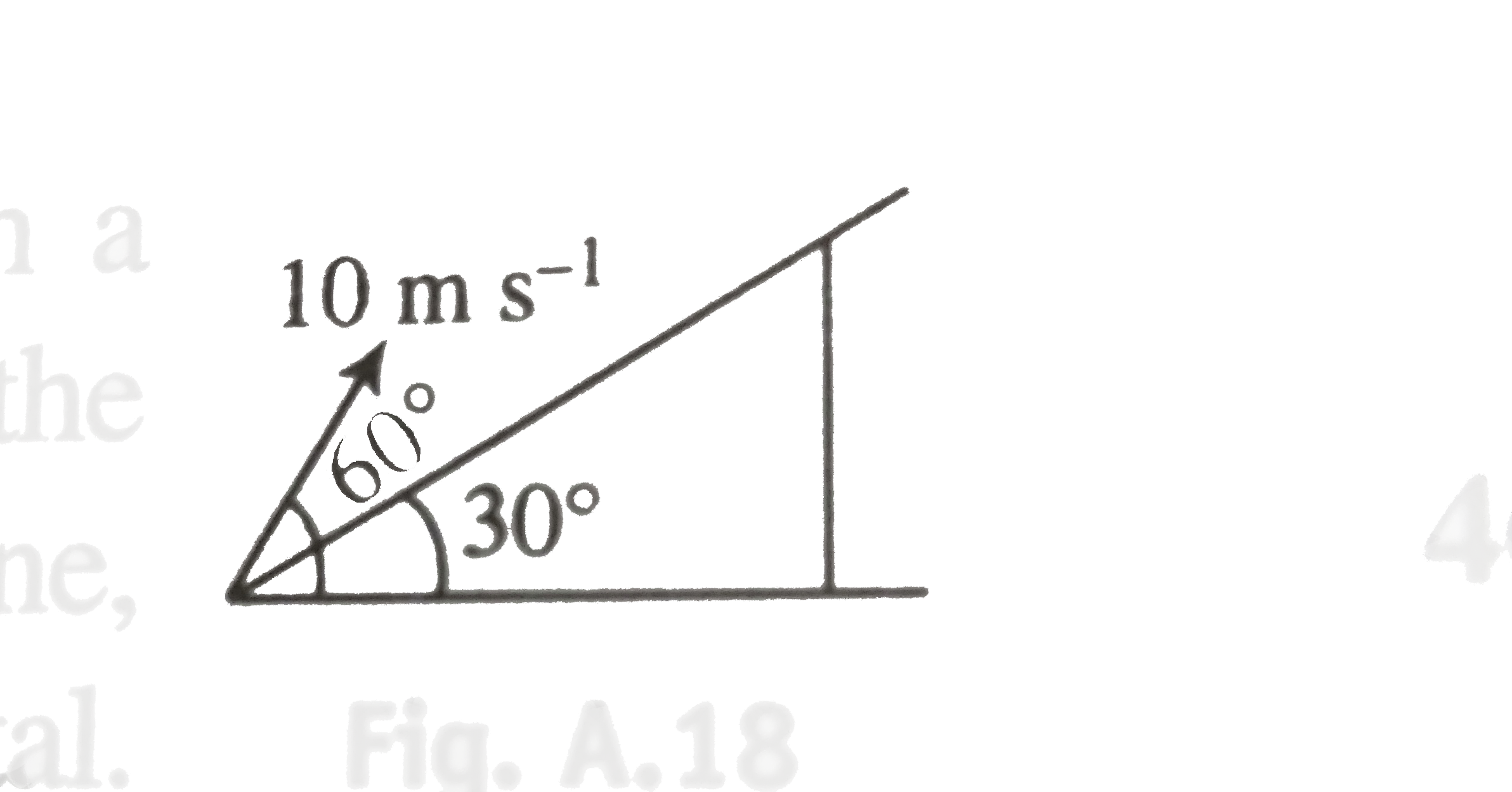A particle is projected with velocity 50 m/s at an angle with the horizontal from the ground. The time after which its velocity will make an angle with the horizontal is
2.5 s
1.83 s
2.37 s
3.72 m
The correct Answer is:B
To solve the problem step by step, we will analyze the motion of the particle and calculate the time at which its velocity makes an angle of 45 degrees with the horizontal.
Step 1: Determine the initial velocity components
The initial velocity V0 is given as 50 m/s at an angle of 60 degrees with the horizontal. We can break this velocity into its horizontal and vertical components.
- Horizontal component V0x=V0cos(60∘)=50⋅12=25m/s
- Vertical component V0y=V0sin(60∘)=50⋅√32=25√3m/s
Step 2: Understand the condition for the angle of 45 degrees
At the time t when the velocity makes an angle of 45 degrees with the horizontal, the horizontal and vertical components of the velocity will be equal. Thus, we need to find the time t when:
Vx=Vy
Step 3: Write the expressions for the velocity components at time t
The horizontal component of velocity remains constant (since there is no horizontal acceleration):
- Vx=V0x=25m/s
The vertical component of velocity changes due to gravity:
- Vy=V0y−gt=25√3−9.8t
Step 4: Set the horizontal and vertical components equal
To find the time when the angle is 45 degrees, we set the horizontal and vertical components equal:
V0x=Vy
Substituting the expressions we have:
25=25√3−9.8t
Step 5: Solve for time t
Rearranging the equation gives:
9.8t=25√3−25
Now, we can factor out 25:
9.8t=25(√3−1)
Now, divide both sides by 9.8:
t=25(√3−1)9.8
Step 6: Calculate the numerical value
Using √3≈1.732:
t=25(1.732−1)9.8
t=25(0.732)9.8
t≈18.39.8≈1.87s
Final Answer
The time after which the velocity will make an angle of 45 degrees with the horizontal is approximately 1.87 seconds.
---
The initial velocity V0 is given as 50 m/s at an angle of 60 degrees with the horizontal. We can break this velocity into its horizontal and vertical components.
- Vertical component V0y=V0sin(60∘)=50⋅√32=25√3m/s
At the time t when the velocity makes an angle of 45 degrees with the horizontal, the horizontal and vertical components of the velocity will be equal. Thus, we need to find the time t when:
The horizontal component of velocity remains constant (since there is no horizontal acceleration):
To find the time when the angle is 45 degrees, we set the horizontal and vertical components equal:
Rearranging the equation gives:
Using √3≈1.732:
t=25(0.732)9.8
t≈18.39.8≈1.87s
The time after which the velocity will make an angle of 45 degrees with the horizontal is approximately 1.87 seconds.
Topper's Solved these Questions
- MOTION IN A PLANEBOOK - AAKASH INSTITUTE ENGLISHCHAPTER - MOTION IN A PLANEEXERCISE - Assignement section -C Objective (More than one option is correct)
7 Videos
- MOTION IN A PLANEBOOK - AAKASH INSTITUTE ENGLISHCHAPTER - MOTION IN A PLANEEXERCISE - Assignement section -D (Linked Comprehension)
12 Videos
- MOTION IN A PLANEBOOK - AAKASH INSTITUTE ENGLISHCHAPTER - MOTION IN A PLANEEXERCISE - Assignement section -A Objective (one option is correct)
50 Videos
- MOCK_TEST_17BOOK - AAKASH INSTITUTE ENGLISHCHAPTER - MOCK_TEST_17EXERCISE - Example
15 Videos
- MOTION IN A STRAIGHT LINEBOOK - AAKASH INSTITUTE ENGLISHCHAPTER - MOTION IN A STRAIGHT LINEEXERCISE - ASSIGNMENT (SECTION - D)
15 Videos
Similar Questions
A projectile is thrown with a velocity of 20 m/s, at an angle of 60∘ with the horizontal. After how much time the velocity vector will make an angle of 45∘ with the horizontal (in upward direction) is (take g=10m/s2)−
View SolutionA ball is projected with a velocity 20√3ms−1 at angle 60∘ to the horizontal. The time interval after which the velocity vector will make an angle 30∘ to the horizontal is (Take, g=10ms−2)
View SolutionA particle is projected with speed 10m/s at angle 60∘ with the horizontal. Then the time after which its speed becomes half of initial.
View SolutionTwo particle are projected with same initial velocities at an angle 30∘ and 60∘ with the horizontal .Then
View SolutionA body is projected with a velocity u at an angle of 60∘ to the horizontal. The time interval after which it will be moving in a direction of 30∘ to the horizontal is
View SolutionA particle is projected with velocity of 10ms at an angle of 15° with horizontal.The horizontal range will be(g=10ms2)
View SolutionA particle is thrown at time t = 0 with a velocity of 10ms−1 at an angle 60∘ with the horizontal from a point on an inclined plane, making an angle of 30∘ with the horizontal. The time when the velocity of the projectile becomes parallel to the incline is

View SolutionA particle is thrown at time t = 0 with a velocity of 10ms−1 at an angle 60∘ with the horizontal from a point on an inclined plane, making an angle of 30∘ with the horizontal. The time when the velocity of the projectile becomes parallel to the incline is

View SolutionA particle is thrown at time t = 0 with a velocity of 10ms−1 at an angle 60∘ with the horizontal from a point on an inclined plane, making an angle of 30∘ with the horizontal. The time when the velocity of the projectile becomes parallel to the incline is

View SolutionA particle is projected at an angle of 60∘ above the horizontal with a speed of 10m/s. After some time the direction of its velocity makes an angle of 30∘ above the horizontal. The speed of the particle at this instant is
View Solution
